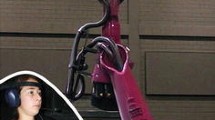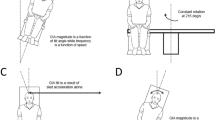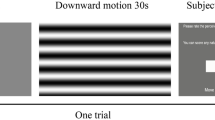Summary
This paper compares the motion sensations of a subject rotated about a vertical axis for two fixed visual fields (a large peripheral field and a single central spot) and in darkness.
Motion sensation is described in terms of threshold, frequency response, and subjective displacement and velocity.
The perception of angular acceleration showed significantly lower threshold and reduced latency time for the illuminated presentation. The level of illumination, however, produced no significant difference in threshold. The subjective frequency response, measured by a nulling method, showed a higher gain in the illuminated presentation, particularly at low frequencies and accelerations. With the subject rotating a pointer to maintain a fixed heading during triangular velocity stimuli, subjective displacements showed no difference for all different visual cues. Magnitude estimates of the after-rotation associated with deceleration from a constant velocity showed a quicker rising speed, larger subjective velocity and longer duration in the illuminated presentation. All the results suggest that the oculogyral illusion is principally responsible for producing a lower threshold in the illuminated presentation, although the fixed peripheral visual field tends to reduce reliance upon vestibular signals. At lower intensity rotation stimuli, this effect is especially apparent.
Similar content being viewed by others
References
Borkenhagen JM (1974) Rotary acceleration of a subject inhibits choice-reaction time to motion in peripheral vision. J Exp Psychol 102: 484–487
Clark B (1967) Thresholds for the perception of angular acceleration in man. Aerosp Med 38: 443–450
Clark B, Stewart JD (1962) Perception of angular acceleration about the yaw axis of a flight simulator. Aerosp Med 33: 1426–1432
Clark B, Stewart JD (1968) Comparison of sensitivity for the perception of bodily rotation and the oculogyral illusion. Percept Psychophys 3: 253–256
Clark B, Stewart JD (1972) Comparison of the sensitivity to rotation of pilots and non-pilots. Aerosp Med 43: 8–12
Clark B, Stewart JD (1974) Choice reaction time to visual motion with varied levels of simultaneous rotary motion. Am J Psychol 87: 441–448
Clark B, Stewart JD (1974) Effects of angular acceleration on man. Choice reaction time using visual and rotary motion information. Percept Mot Skills 38: 735–743
Dixon WT (1973) BMD-biomedical computer programs. University of California Press, Los Angeles
Doty RL (1969) Effects of duration of stimulus presentation on the angular acceleration threshold. J Exp Psychol 80: 317–321
Graybiel A, Hupp DI (1946) The oculogyral illusion. J Aviat Med 17: 3–27
Groen JJ, Jongkees LBW (1946) The threshold of angular acceleration perception. J Physiol (Lond) 107: 1–7
Guedry FE (1974) Psychophysics of vestibular sensation. In: Kornhuber HH (ed) Vestibular system, Part 2: Psychophysics, Applied aspects and general interpretation. Springer, Berlin Heidelberg New York, pp 1–154
Guedry FE, Owens GG, Norman JW (1969) Assessment of semicircular canal function. I. Measurement of subjective effects produced by triangular waveforms of angular velocity. National Aerospace Medical Institute, Pensacola, FL
Guedry FE, Stockwell CW, Norman JW, Owens GG (1971) Use of triangular waveforms of angular velocity in the study of vestibular function. Acta Otolaryngol [Stockh] 71: 439–448
Guedry FE, Richmond G (1957) Differences in response latency with different magnitude angular acceleration. Report 301, Psychol Dept. US Army Med Res Lab., Fort Worth, KY
Gundry AJ (1977) Thresholds to roll motion in a flight simulator. J Aircr 14: 624–631
Henn VS, Young LR, Finley C (1974) Vestibular units in alert monkeys are also influenced by moving visual scenes. Brain Res 71: 144–149
Marshall JE (1967) Visual-vestibular interaction and threshold for angular acceleration. Report 704, Exp Psychol Division, US Army Med Res Lab., Fort Knox, KY
Meiry JL (1965) The vestibular system and human dynamic space orientation. Sc.D. Thesis, MIT, Cambridge, MA
Melvill Jones G, Barry W, Kowalsky N (1964) Dynamics of the semicircular canals compared in yaw, pitch and roll. Aerosp Med 35: 984–989
Melvill Jones G, Young LR (1978) Subjective detection of vertical acceleration. A velocity dependent response? Acta Otolaryngol [Stockh] 85: 45–53
Ormsby CC (1974) Model of human dynamic orientation. Ph. D. Thesis, MIT, Cambridge, MA
Owens GG, Guedry FE (1969) Assessment of semicircular canal function. II. Individual differences in subjective angular displacement produced by triangular waveforms of angular velocity. Naval Aerospace Medical Institute, Pensacola, FL
Parsons RD (1970) Magnitude estimates of the oculogyral illusion during and following angular acceleration. J Exp Psychol 84: 230–238
Peters RA (1969) Dynamics of the vestibular system and their relation to motion perception, spatial disorientation and illusions. NASA, CR-1309, System Technology Inc., Hawthorne, CA
Stewart JD, Clark B (1975) Choice reaction time to visual motion during prolonged rotary motion in airline pilots. Aviat Space Environ Med 46: 767–771
Van Egmond AAJ, Groen JJ, Jongkees LBW (1949) The mechanics of the semicircular canal. J Physiol (Lond) 110: 1–17
Waespe W, Waespe B, Henn V (1978) Vestibular neuron activity and subjective sensation during conflicting vestibular-visual stimulation in monkey and man. Pfluegers Arch [Suppl R87] 373
Waespe W, Henn V (1978) Conflicting visual-vestibular stimulation and vestibular nucleus activity in alert monkeys. Exp Brain Res 33: 203–211
Young LR, Oman CM (1969) Model for vestibular adaptation to horizontal rotation. Aerosp Med 40: 1076–1080
Zacharias GL, Young LR (1981) Influence of combined visual and vestibular cues on human perception and control of horizontal rotation. Exp Brain Res 41: 159–171
Zacharias GL (1977) Motion sensation dependence on visual and vestibular cues. Ph.D. Thesis, MIT, Cambridge, MA
Zacharias GL (1977) Motion cues for pilot-vehicle analysis. Bolt Beranek, Newman, Cambridge, MA
Author information
Authors and Affiliations
Additional information
This research was supported by NASA Ames Research Grants NSG 2012 and 2230
Rights and permissions
About this article
Cite this article
Huang, J., Young, L.R. Sensation of rotation about a vertical axis with a fixed visual field in different illuminations and in the dark. Exp Brain Res 41, 172–183 (1981). https://doi.org/10.1007/BF00236606
Received:
Issue Date:
DOI: https://doi.org/10.1007/BF00236606




